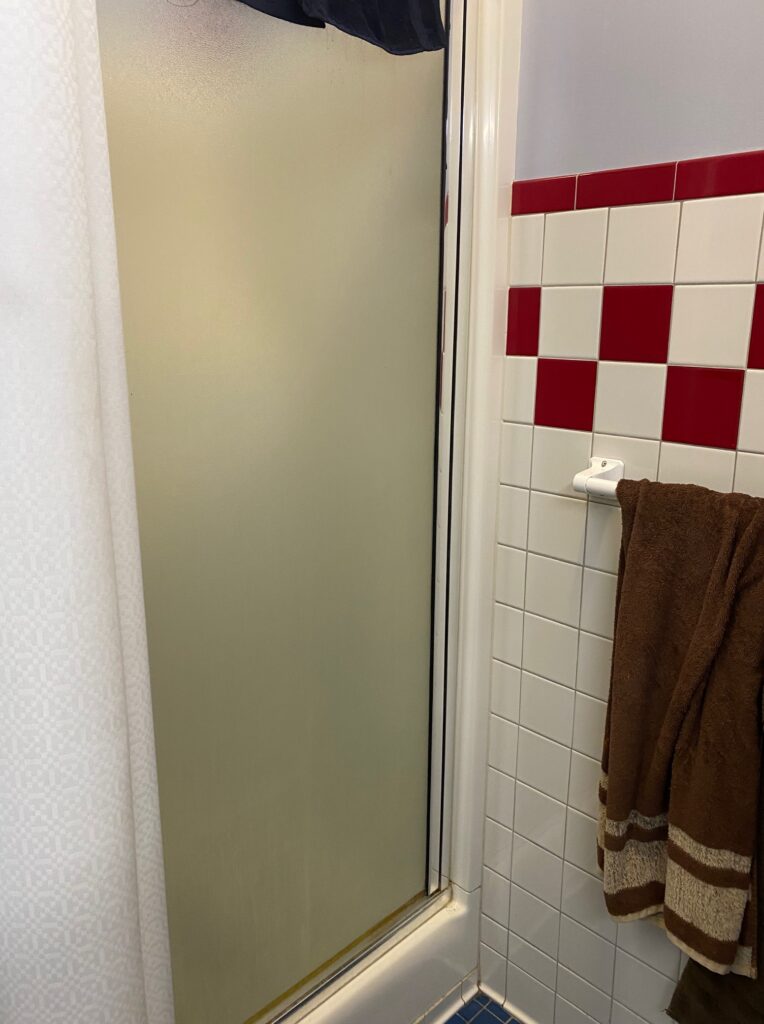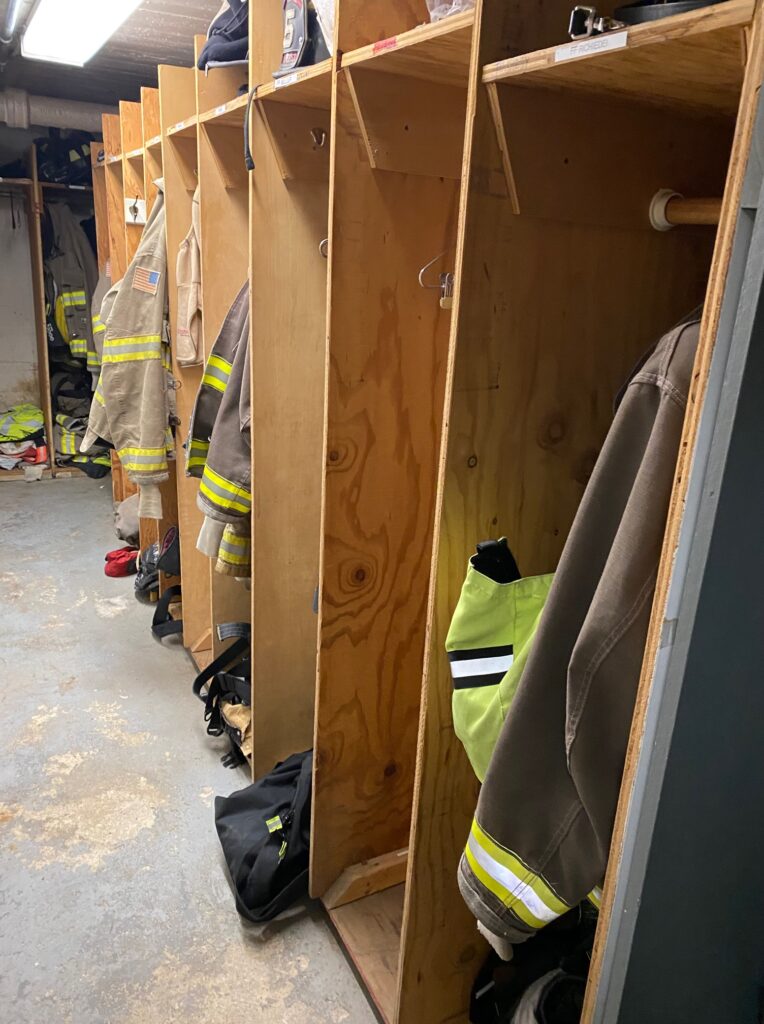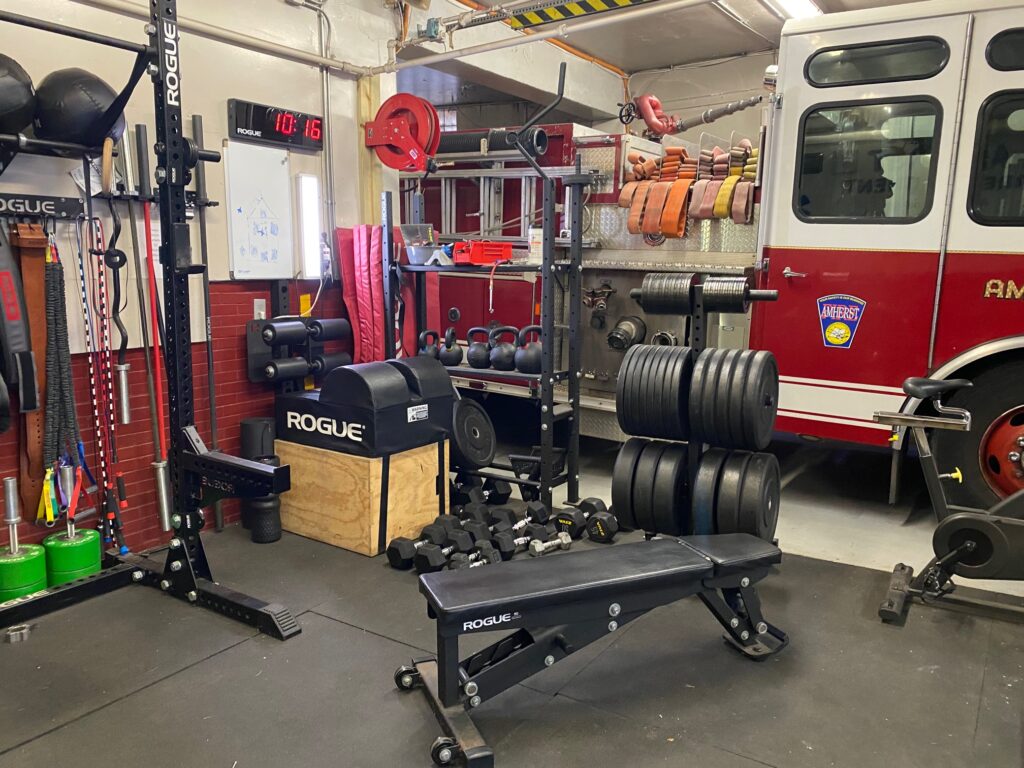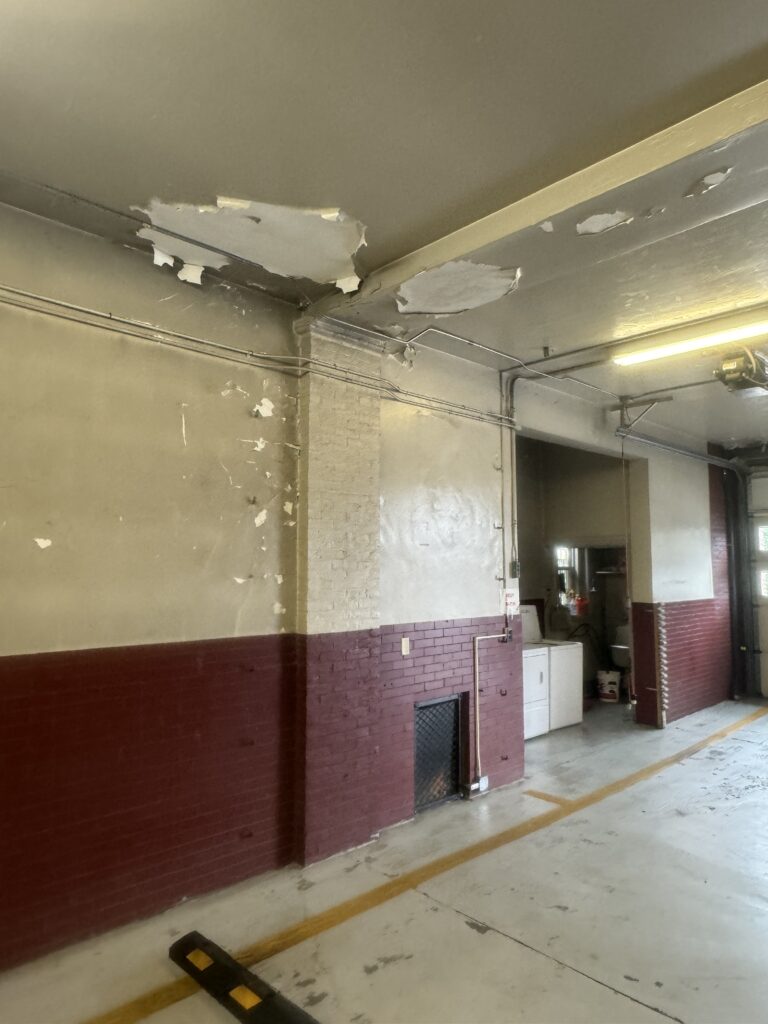Understaffing and Inadequate Facilities Are Chronic Problems for Amherst Fire Fighters
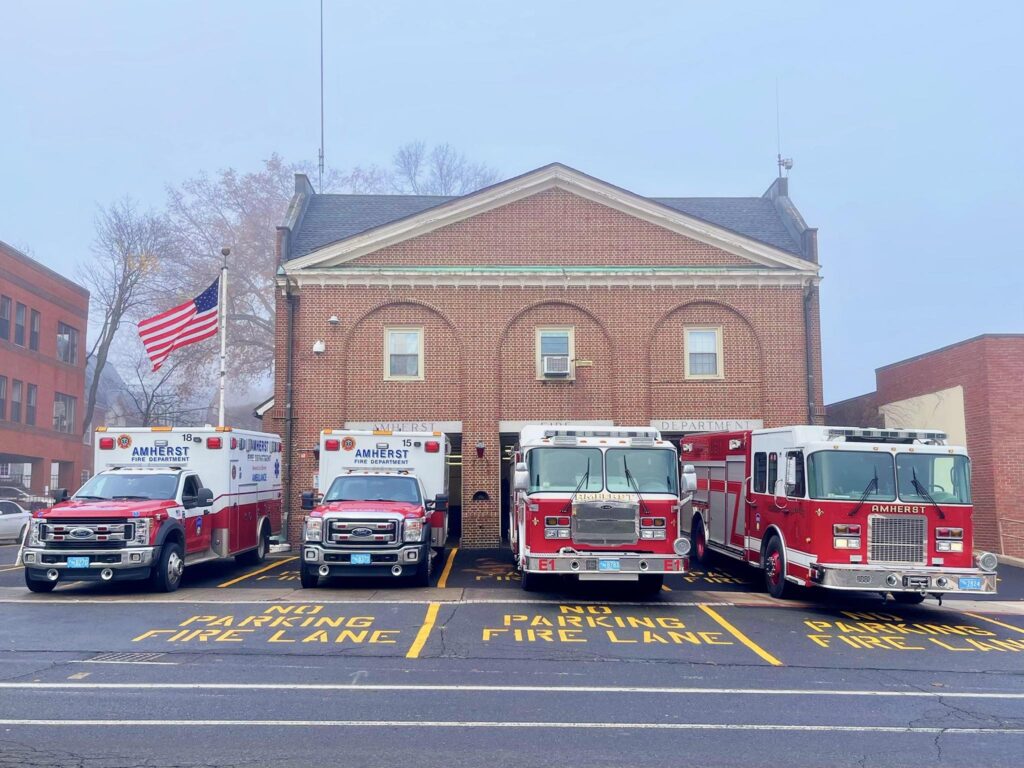
Amherst's central fire station. The town manager will soon appoint a committee to begin planning a new Amherst fire station. Photo: Amherst Firefighters Local 1764
by Art and Maura Keene
We sat down on Labor Day with Sarah Forsaith, president of Amherst Firefighters Local 1764, and Nick Chirekos, vice president of the union, to discuss the staffing shortage that produced inadequate coverage of the town on July 1, and the ongoing challenges that Amherst firefighters face in keeping the town safe. Prior to our conversation, we took a quick tour of the central fire station, which underscored what is widely recognized throughout the town, that the 94-year-old building is too small, unsafe, and inadequate to meet the needs of the force stationed there.
Our conversation was prompted by a letter Forsaith published in both the Indy and the Daily Hampshire Gazette following the July 1 incident. That evening there were were nine firefighters on duty. three ambulances were out on calls with two fire fighters each. Engine 2 was on a call as an EFR (emergency fire response) waiting for a mutual aid ambulance with 2 firefighters. That left Engine 1 available with 1 captain, leaving the entire town covered by a single firefighter. This firefighter responded to an alarm at 63 South Pleasant Street on their own, with no other on-duty members available to respond with them. The second firefighter to arrive on scene was the acting chief of the department, who had to pump the engine to provide water during the initial attack to suppress this fire. Forsaith pointed out that although they extinguished the fire before it could spread further, the outcome of this incident could have been much worse—and warned that this type of understaffed response to calls is, unfortunately, quite common in Amherst.
Former Amherst Fire Chief Tim Nelson had raised concerns about the chronic understaffing of the Amherst Fire Department (AFD) for years, including in an interview in 2019 when he told MassLive that a staffing study conducted in the 1960s stated there should be at least 15 firefighters on staff per shift in Amherst, but “Almost 60 years later, call volume has increased by 500% and the department often has as few as seven firefighters on duty at a time.”
Some New Equipment on the Way
Forsaith and Chirekos said that Amherst firefighters have been facing the same chronic challenges of understaffing, inadequate and unsafe facilities, and aging equipment for decades. The addition of a new hybrid ambulance in 2022 (after a harrowing accident with one of the department’s older vehicles) and a new ladder truck that is expected to arrive by 2025 will help. In addition, the town has received a grant to acquire PFAS-free turnout gear for the force for use in non-fire related calls like automobile accidents, and will contribute to the health and safety of firefighters. Each employee will get a new set of structural gear and a set of nonstructural PFAS free gear.
The fire and police departments have received an allocation for new dispatch equipment to replace the town’s failing public safety radio system. The new system will allow firefighters to communicate with each other, which the existing antiquated and failing system does not always allow.
But despite these new and anticipated acquisitions, equipment is typically pushed beyond its optimal use life. For example, Amherst’s ambulance fleet of five ambulances is typically in service well past its optimal use life and this was underscored by an accident in 2022 when the two passenger side wheels sheared off an ambulance during a hospital run. Forsaith was driving the vehicle at the time and the accident led then local 1764 president Ben Graham to write to the Town Council, “Your firefighters have been requesting the resources that we need to serve our community safely and effectively. We have expressed our needs for additional staffing, the replacement of our failing vehicles and equipment, and the negative effect that those issues have on the morale and operation of our department. These issues are beginning to spiral out of control, and are risking the physical and mental health of your firefighters.”
Forsaith reported that ambulances ought to be replaced more often than they are. Currently the department is on a 10-year replacement cycle and has two new ambulances on order.
Turnout gear (that is, the protective clothing worn by firefighters) is also a problem. While some new gear is coming, Forsaith reported that some firefighters do not have a second set of appropriate gear and some don’t even have one full set, much less a backup.
And the new ladder truck, expected to be delivered next year, replaces a vehicle that is 34 years old.
But the understaffing that creates crises like the incident of July 1, and glaringly inadequate facilities have been a constant lament and threat to public safety for Amherst firefighters for decades. Most striking in our conversation was the fact that while call volume has increased dramatically over the years and the demands of the job have grown ever more complex, and the dangers posed by short staffing and inadequate facilities become ever more apparent, nothing seems to change.
The Staffing Problem
Forsaith pointed out the AFD is chronically understaffed, well below national standards and that in spite of this problem being evident for decades, and in spite of call volume increasing, nothing has been done to address the problem. (See here for a 2021 interview with Chirekos)
She said, “With our current staffing model, we use eight firefighters to staff three ambulances and two engines…and, as was the case on July 1, the math just doesn’t work. There is no safe way to ensure that every single response gets the safe amount of staffing that it needs. We are not staffing according to national standards and regulations. We are relying on an ambulance not being called or not needing an extra person and that multiple calls won’t come in while we are answering others. For any alarm, we should have four firefighters responding, and we’re not doing that. The number we try to hit every time we go out is three, and we are often not doing even that.”
Chirekos added ,”We have plenty of high rises in Amherst. We send an engine. We get one engine and three people for an entire high rise building. Crazy. It’s untenable. We have been lucky that something tragic has not happened.”
He also noted that Northampton, a city of roughly similar size to Amherst, staffs at almost twice the rate of Amherst. In his 2021 interview with the Indy he said, “Northampton has 32,000 residents. The Northampton Fire Department ran a total of 7,394 emergency calls with 5,495 ambulance calls in 2019. The Amherst Fire Department covered 5,741 emergency calls with 4,192 ambulance calls in 2019. Our staffing problems also affect other communities, and people suffer because of it. In 2019, we were unable to respond to over 105 EMS calls and had to request mutual aid from other communities. “Northampton currently has a comparable call volume to Amherst — but they have a minimum of 13 firefighters on duty, almost two times that of Amherst. It’s also worth noting they also have a hospital in their city, whereas our nearest hospital is eight and a half miles away from our central fire station. Our call volumes in Amherst are tracking to be the highest they’ve been in the last three years, yet nothing has changed for the better. In fact things appear to be getting worse,” Chirekos said.
Forsaith cited a 2016 staffing study that said the AFD should have a staffing level of 15, almost double what they curreently have. And since then, the service population has grown.
According to Forsaith and Chirekos, demands on the Amherst Fire Department have grown as the population of Amherst has grown but the calls have also become more complex as the local population is aging and increasingly diverse. Amherst firefighters have been meeting the demand by understaffing their calls and relying on mutual aid from other neighboring communities when necessary. Mutual aid is common across the country and Hadley, Northampton, and Belchertown are commonly called in to help when the AFD is short-staffed. Chirekos noted that Amherst’s EMS (emergency medical services) utilized far more mutual aid than they gave, and this impacts departmental budgets and revenue.
Forsaith added, “In Amherst the force has been static — not gone down but the call volume has gone up considerably, especially ambulance calls. Both firefighters emphasized that this growth in EMS calls was not attributable primarily to the university. “College kids are not the major source of our call volume—maybe 30% of our calls,” Forsaith said. Although the student share of calls is difficult to track because of off-campus housing, she was confident that students are not the main source of emergency medical calls.
“And for those student events that require a larger public safety presence, like the first week of classes, Blarney Blowout, or Hobart Hoedown, we can plan for them. We know when they are coming and we can staff up. But the crisis of July 1, that is hanging over us every single day.”
Understaffing is a tragedy waiting to happen. Sooner or later our luck is going to run out.
Forsaith and Chirekos did not have figures on how common such understaffing was, but emphasized that it felt pervasive and happened not once but twice in the week of July 1 alone. Both underscored that the chronic understaffing posed a considerable threat to public safety and to firefighters and that the current situation is “a tragedy waiting to happen.” Both stressed that “sooner or later our luck is going to run out.”
Why So Few Firefighters?
In the past four decades call volume across the nation has tripled while the number of firefighters have fallen by about 25%. But while the nation is facing an alarming shortage of firefighters, Amherst’s neighbors have succeeded in staffing more fully than Amherst has, and the understaffing here appears to be a matter of budgetary policy.
“People in local government are aware [of this], and we’ve been in discussions with the Town Manager and members of the Town Council,” Forsaith said, “and members of the public have started to speak up. I’ve had these conversations with the Town Manager where he’s asked, ‘What can I do to improve the situation?’ and I’ve said it has to begin with staffing. And that has just not happened. We would like to see addressing these needs of the AFD prioritized as one of the Town Manager’s goals.” [Editor’s note: Each year the Town Council defines a set of goals that they expect the Town Manager to prioritize.] She added, “We’re all out all year round, and we need some help.”
Chirekos noted that Northampton “has in the neighborhood of 70 people on staff and this is simply because they’ve made the funds available to hire a force of that size.” Forsaith added, “July 1 is always just one or two calls away.“
Chirekos summed up, “We routinely run with only one person covering the town while the others are out on calls. This is a regular practice. That is a bad story waiting to happen.”
Facilities
Our tour showed clearly that the central fire station is simply too small to house modern equipment and provide the safety features firefighters need.
For example, there is no space for proper decontamination after firefighters go out on a call and they often have to decontaminate at the North Amherst station. Hoses and equipment have to be cleaned in North Amherst. Storage for turnout gear is inadequate, which may contribute to a shorter use-life. Engines must be customized to fit into the narrow bays of the firehouse, and in spite of exhaust-venting hoses on all vehicles, there is concern about air quality in the station, where firefighters have to sleep. There is one shower available for the entire station. Forsaith said that OSHA standards are not applied to this station.
The need for a new fire house has been widely recognized and the original capital plan of 2019 had a new fire house slated to be completed in 2027 at a cost of $24M, far less than the current $55M estimate for the Jones Library renovation and the $97M new elementary school. A site for the new fire house has yet to be identified, though there has been talk of locating it at the former Hickory Ridge Golf Course, purchased several years ago by the town.
Chirekos pointed out that Hickory Ridge is not an optimal location to meet the needs of the town because call volume is highest in the center of town and is relatively low in South Amherst. He said that he greatly appreciates that the town is seeking a proper location for a new fire house, but noted that as far as he knows, there is no design committee for a new fire house and no firefighters have been approached for input on what is needed in a new facility.
Supporting the AFD
Both firefighters encouraged the public to get involved and direct the Town Council to make adequate staffing of the AFD a Town Manager priority. They invite the public to come to an open house at the central fire station during national fire prevention week in early October and to see the facilities for themselves and speak with firefighters about their experiences.
